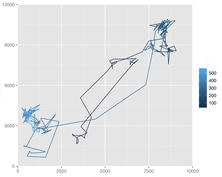Publication trimestrielle du Laboratoire
d'analyse et d'architecture des systèmes du CNRS
Future space exploration missions aim at landing and returning samples from moon, planets and asteroids. Autonomous precision landing capabilities will have to reach pre-selected landing sites which may lie near hazardous terrain features such as craters, rocks. However, past and current robotic landers are still far from this ability. For example, the rover Mars Science Laboratory, to be launched in 2011, is programmed to land on a position with an error of several kilometers.The first goal of thesis is to propose a vision-based absolute navigation system, named Landstel, for interplanetary landers, especially for missions on Mars or on Moon. Contrary to current absolute navigation systems proposed in the literature which rely either on the usage of image intensity or on specific surface landmarks like craters, Landstel employs the topological property of generic surface landmarks. As a result, Landstel is not restricted to any particular terrain. Landstel also exhibits a high robustness with respect to illumination variations and sensor noise. In addition, the use of surface landmarks allows Landstel to drastically reduce the required onboard memory. Besides Landstel, the second goal of the thesis is to propose a framework to integrate Landstel inside a complete navigation system called VIBAN, including both absolute localization, inertial navigation and/or visual odometry. The absolute position estimate returned by Landstel is firstly verified using the visual odometry tracked points. Then, the verified position estimate is fused with the velocity estimate of the visual odometry in a Kalman filter to improve the estimated position. The updated position is later returned back to Landstel which increases the speed of Landstel by focusing the search for matches and reduces the probability of false estimations. Finally, the points tracked by visual odometry are fed to Landstel to augment the number of matches returned by Landstel. Besides these interests, the integration scheme does not impose any constraints on the spacecraft velocity or angular rate.Extensive experiments with PANGU, a surface simulator, and with Earth images validate the proposed system.





